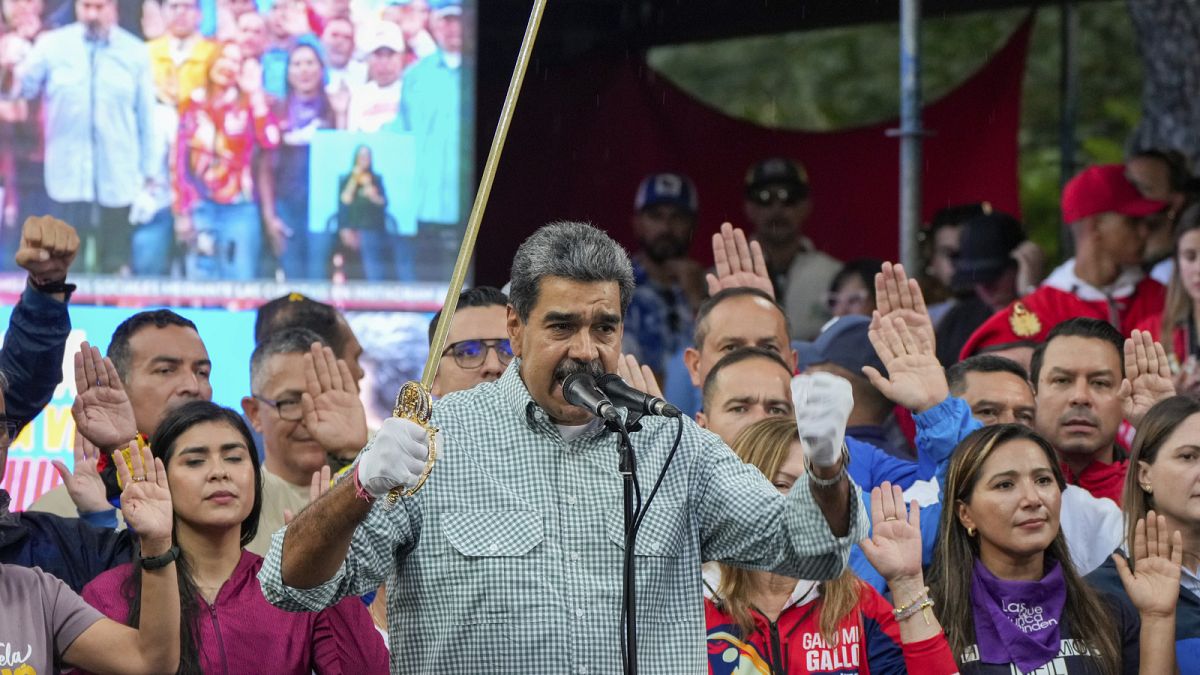Sports
Column: 'I don't see why not.' Diamondbacks primed to take down Dodgers again
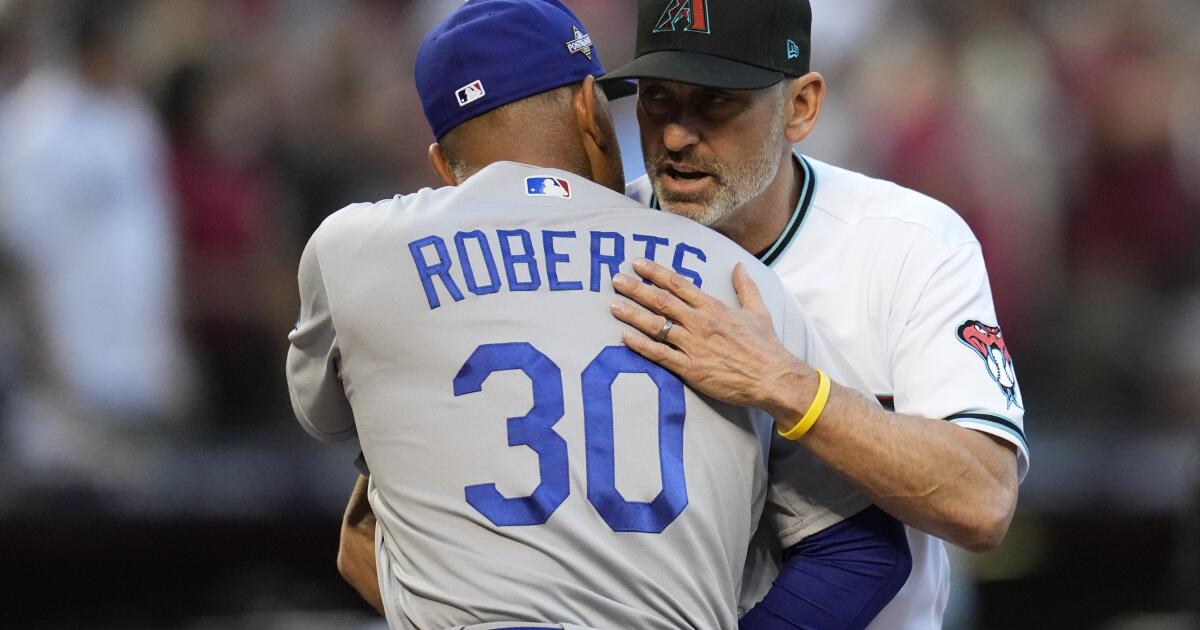
Torey Lovullo is L.A. through and through: born in Santa Monica, son of a Hollywood producer, played his high school ball at the old Montclair Prep in Van Nuys, starred at UCLA. He managed the Arizona Diamondbacks into the World Series last year, but he cannot persuade his friends and extended family to surrender their allegiance to the hometown Dodgers.
“About 80% of my family,” Lovullo said, “are Dodger fans.”
He goes to neighborhood holiday parties, where the talk is how great the Dodgers are going to be with Mookie Betts or Shohei Ohtani or whoever. His mother bleeds Sedona red, but the spouses of his siblings do not, and neither do most of his high school and college friends.
“There’s no conversion there,” Lovullo said. “They’re 100% bleeding Dodger blue.”
That could make for a lighthearted subplot this weekend, with the Diamondbacks within three games of the Dodgers in the National League West before Thursday’s action. The teams open a four-game series here Friday, with the postseason five weeks away.
The latest Baseball Prospectus projections give the Dodgers a 100% chance of making the playoffs, the Diamondbacks a 97% chance. The Diamondbacks eliminated the Dodgers from the playoffs last year, and they could do it again this year.
“I don’t see why not,” Arizona pitcher Merrill Kelly said. “I definitely think we’re a better team than we were last year, top to bottom.
“If we can beat them then, we can definitely beat them now.”
The Diamondbacks, remember, were the last team into the playoffs last year, a team that finished 16 games behind the Dodgers, a team that won 84 games in the regular season and then dismissed the Dodgers in three games in October.
When America says “fluke,” the Diamondbacks shrug.
“I think most people thought it was a fluke,” Arizona president Derrick Hall said. “We sort of limped and backed into the playoffs, and then we got hot at the right time. Look at the World Series matchup: It was two wild-card teams that barely got in.”
Said general manager Mike Hazen: “I think any reference I have heard for the last year — including when I talk about it — is that we were an 84-win team. That is automatically implying we were a fluke. And I get that. I think it’s fair. If you’re an 84-win team, you shouldn’t have the expectation that you are going to play in the World Series.
“We got hot, and we played well, but we wanted to springboard off that. We didn’t want the story to be that we were just a fluke. We worked hard at that this offseason, to ensure that what happened last season was hopefully the first of a few appearances in the postseason, and not just one and done.”
The Diamondbacks spent the money to get better, which is what you want. The results were not what you want, at least not at first: Pitcher Eduardo Rodriguez, who vetoed a trade to the Dodgers last year, signed for $80 million, then suffered a shoulder injury in spring training. Pitcher Jordan Montgomery, signed for one year and $25 million, carried an ERA over 6.00 into the All-Star break. Outfielder Corbin Carroll, signed for $111 million during his 2023 rookie of the year campaign, was batting .210 with two home runs through June.
Montgomery is in the bullpen now, his ERA still above 6.00. Rodriguez finally made his season debut this month; he is undefeated in four starts. In July and August, Carroll has 15 home runs, and an OPS above .900.
The Dodgers have the superstars atop their lineup, but the Diamondbacks lead the major leagues in runs scored. They get on base more often than any other team in the NL, running up pitch counts and ousting starters early.
“The Dodgers have been the prime example of that,” Lovullo said.
Every Arizona player with at least 100 at-bats has an on-base percentage over .300. On Wednesday, the Diamondbacks won when their No. 8 and No. 9 batters drew two-out walks in the eighth inning against Edwin Diaz, the star New York Mets closer, and Carroll followed with a game-winning grand slam.
All that offense is all the more impressive at a time they are winning with arguably their three most productive hitters this season on the injured list: cleanup batter Christian Walker, catcher Gabriel Moreno and second baseman Ketel Marte, whom Lovullo chose over Ohtani as the NL leadoff batter in the All-Star Game.
The Diamondbacks’ Corbin Carroll celebrates after hitting a go-ahead grand slam in the eighth inning against the Mets on Wednesday night.
(Rick Scuteri / Associated Press)
The reinforcements and the revived include a veteran platoon at designated hitter — Dodgers alum Joc Pederson (career-high .946 OPS) and Angels alum Randal Grichuk — third baseman Eugenio Suarez, who leads the NL in runs batted in since the All-Star break, outfielder and former first-round pick Jake McCarthy (.809 OPS) and catcher and former second-round pick Adrian Del Castillo (batting .354 in 14 games).
The Diamondbacks acknowledge Betts and Max Muncy have missed significant time and the Dodgers have won without a lineup at full strength, just as Arizona has.
Still, the national reaction hits different when the topic is Walker, Moreno and Marte here as opposed to Ohtani, Betts and Freeman in Los Angeles.
“The Dodgers have been a national brand for however long they have been around,” Arizona pitcher Zac Gallen said. “They have been the team in the NL West, and they have been in the playoffs for however many years.
“Not to take anything away from those guys — you’re talking about three of the best players in all of baseball — but I would be intrigued what Ketel Marte’s case would look like in terms of MVP if he didn’t play in Arizona. What does it look like if he is playing in one of those big markets? Is it as strong as some of those other guys?”
Ohtani leads the NL with 42 home runs. He is batting .295, leads the NL in OPS and ranks second in RBI and stolen bases. Marte is batting .298 with 30 home runs; he ranks third in OPS. He also plays a key defensive position; Ohtani is a designated hitter.
Baseball Reference has Ohtani leading the NL in WAR (6.7), followed by Marte (6.0). Fangraphs has the Mets’ Francisco Lindor leading the NL in WAR (6.6), followed by Ohtani (6.4).
Ohtani should win the MVP race, but the Diamondbacks would be fine if he won and they made back-to-back appearances in the World Series — this time, followed by a parade.
The Dodgers have seven pennants on display at Dodger Stadium, one for each of the seven World Series championships in franchise history.
The Diamondbacks proudly post 10 logos high above the outfield at Chase Field, in recognition of one World Series championship, two league championships, five division championships, and two wild-card berths.
Frankly, Lovullo said, he would like the Diamondbacks to display World Series championships only, just as the Dodgers do. That, of course, would require winning multiple World Series championships.
“That’s what great organizations do: the Yankees, the Dodgers, the Red Sox, to name a few,” he said. “They don’t just do it once. They validate it by doing it over and over. I hope we get to that point one day, but it’s still a young franchise. It’s only 25 years old. It’s going to take a little time to get to that level.
“In 100 years, I do hope that we have nothing but world championships up there, and that our group and our time was responsible for hanging a couple of those banners.”

Sports
Selhurst Park at 100: Why one of England’s least loved grounds really matters

“I never realised what a magical world it was. It was just people and families and colour and joy. The smell of hotdogs, people selling scarves and souvenirs. It was like I’d gone into this magical world I didn’t even know existed,” Hy Money, photographer and Crystal Palace fan, of her first visit to Selhurst Park in 1971 (cpfc.co.uk).
Not everyone sees the magic, admittedly. If you prefer a modern stadium with a park-and-ride next door and a bit more legroom, Selhurst Park is never going to figure on your list of favourite grounds.
Maybe you have sat in the away end and been able to see only two-thirds of the pitch. Maybe you don’t understand why a large Sainsbury’s supermarket is tacked onto one side of the stadium. Or maybe a bit of snobbery has set in after all these years of the tills-ringing Premier League.
Simon Inglis, the author and football historian, recommended as long ago as 1983 that Crystal Palace might be better off without the stadium that Archibald Leitch, the architect who designed it, predicted would be the biggest in London.
Inglis took the view — “to be really provocative” — that the club should share the athletics stadium two miles away. Leitch’s portfolio included Stamford Bridge, Craven Cottage, Anfield, Goodison Park, Old Trafford and many more. Selhurst Park, Inglis wrote, was “never one of Leitch’s best”.
Archibald Leitch’s Main Stand under construction at Selhurst Park in 1924 (Osbourne/Topical Press AgencyHulton Archive/Getty Images)
And fair enough, even if Inglis mentions in his renowned book, Football Grounds of Britain, that the unorthodox look of Selhurst Park is also part and parcel of its character and appeal.
Tomorrow (August 30), it will be 100 years old. Yet Palace fans should know from experience that not everybody will want to commemorate the anniversary. Selhurst Park gets a bad name sometimes. Barring Goodison Park — which Everton are vacating at the end of this season for a new 53,000-capacity ground — it is the least recently developed stadium in the Premier League and ranked 18th in The Athletic’s survey of Premier League grounds last year.
And yet, there is plenty to like, too. Look closely enough and maybe, this week of all weeks, attitudes can soften and we can show some love to one of English football’s most unappreciated stadiums. Because there is more good than bad, even if it has been a close-run thing at times.
“It’s not iconic,” says Steve Coppell, one of the managers who count as Selhurst Park royalty. “It’s not architecturally unique or superb. Opposition teams hate it because the dressing rooms are so small. It’s quirky, it’s difficult to get to. It’s a patchwork quilt of a stadium — but if you are a Palace fan, you love it.”
“Why did the media relish slagging off Selhurst Park so much? There’s one big reason: the media facilities aren’t that great. And why’s that? Because the media have consistently had a go at me for the last five years, so I took their biscuits away,” Simon Jordan, Crystal Palace owner, 2000 to 2010, in The Guardian.
Head along Whitehorse Lane, past the Mayhem vape shop, the Dutchie (Caribbean food), Danyame’s Kitchen (Afro-Ghanaian) and the boarded-up shell of what used to be the London Tavern pub and the first entrance to Selhurst Park comes in the form of the Sainsbury’s superstore that has adjoined the stadium for more than 40 years.
Supporters of a certain generation might be familiar with the parade of shops where the players used to get their lunch at Berto’s cafe and the barber’s, which had pictures on its walls of the owner, Enzo, trimming the hair of Don Rogers, one of the crowd favourites.
It is a different selection of shop names and food places these days. The Original Tasty Jerk, where Berto’s used to be, is reputed to sell the best jerk chicken in south London (and there is plenty of competition for that title): if the wind is blowing in the right direction, the smell drifts over the fan zone into the stands on matchdays. In 2017, Palace even nodded to its popularity by tweeting a video of its chimney puffing white smoke — ‘Vatican-style’ — in anticipation of the announcement of Frank de Boer as manager.
💭💭💭 pic.twitter.com/ruXld8jy08
— Crystal Palace F.C. (@CPFC) June 26, 2017
The opposition on August 30, 1924, was The Wednesday — or Sheffield Wednesday, as they became known — and the first game at Selhurst Park featured the early symptoms of a condition that is sometimes known among modern-day fans as “typical Palace”. They lost 1-0. The goal was scored after four minutes and the official opening by the Lord Mayor of London took place in a still unfinished stand because of delays and strikes.
A century on, it is still possible to find families in the nearby streets who, going back through the generations, have lived here even longer than the stadium on their doorstep. Stickers on Holmesdale Road’s lamp-posts proclaim, Sex Pistols-style, “Never Mind the Brighton, Here’s the Palace.”
The mural for Wilfried Zaha at the junction of Park Road brings a dash of colour to the suburban backcloth (just a shame, perhaps, that he left for Galatasaray a couple of months after it went up). In the Clifton Arms, the closest pub to the ground (“Home Fans Only!”), the beer garden is splashed in Palace colours.

The Wilfried Zaha mural at Selhurst Park (The Athletic)
What has never changed are the gripes and sneers that have attached themselves to this part of SE25, in the London borough of Croydon, for longer than Palace fans would probably wish to remember.
“The location, mainly,” says Coppell, with the weary tone you might expect of someone who has been hearing these complaints for four decades. “I get loads of people asking me, ‘What’s the best way to get to Selhurst Park?’. I say to them, ‘There is no best way — tell me what time you’re going, where you’re coming from, and I will tell you what is probably the best way’. But I could tell them the best way and they still might be stuck in traffic for an hour and a half.”
Coppell had four spells as Palace manager, including a transformational nine-year stint when he took the club back into England’s top division, led them to their first FA Cup final and, in 1990-91, their highest finish of third place.
Crowds had dipped below 6,000 in Coppell’s first year in charge and the Holmesdale Road end, now the biggest of Selhurst’s four stands and home to its most boisterous fans, was “just a mound behind the goal” — a rough bank of concrete terracing with metal fences at the front and a chunky, angular floodlight in each corner.
Palace, Coppell recalls, were skint — not bucket-collection broke, but skint all the same. Various events were put on to raise money, including a “gentleman’s evening” with comedian Bernard Manning. It was the ultimate indignity — Manning preferred to get his dinner from the chip shop rather than eat whatever the club dished up.

Selhurst Park with the old Holmesdale terrace in the foreground (Anton Want/Allsport/Hulton Archive/Getty Images)
As for the manager’s office, that was another part of the stadium’s irregular design. “It was above a fish and chip shop,” says Coppell. “It’s the souvenir shop now but, back then, it was a chippy called ‘The Seafarer’. My office was baking hot because of the heat coming through from the fryers and it stunk of fish and chips.”
The context here is important. In 1924, Palace were a year away from falling into Division Three South. They could afford to install a tap by the trainer’s bench for wetting the magic sponge. Despite their regal name — shared with the area of London slightly to the north of Selhurst Park where Palace originally played — the club did not have the money for the brick detailing, roof gables and fancy trimmings that Leitch added to Highbury and Stamford Bridge.
In the 100 years since, Palace have never had the wealth of London’s more glamorous clubs — and that, more than anything, explains why their stadium has only had sporadic development, bit by bit, and why Jordan recalled it being in “an absolute state of disrepair” when he began his 10 years of ownership.
“Virtually everywhere you looked, it was coming down,” Jordan writes in his autobiography, Be Careful What You Wish For. “The lounges were like the inside of a restaurant that hadn’t been redecorated since the 1970s.”
That was 2000 and, within a week, a letter had arrived to inform Jordan the roof on the Arthur Wait stand was unsafe and needed replacing as a matter of urgency. “The safety council for the Football League told me I had three weeks to do it or close the stand for the season,” he recalls.
The training ground in nearby Mitcham was even less salubrious (it should have been “condemned” is Coppell’s take) and still had the communal bath that became infamous because of the 1976 photograph of Malcolm Allison — showman, playboy and, back then, Palace’s manager — sharing the water with soft porn actress and vicar’s daughter Fiona Richmond.

Malcolm Allison was a flamboyant manager for Crystal Palace (Michael Webb/Keystone/Getty Images)
So where did managers in those days take prospective new signings when they were trying to convince them to join the club?
“Most of my business was done at the old Happy Eater restaurant on Junction 7 of the M25,” says Coppell. “It (Selhurst) was better, marginally, than the training ground. But it was always bibs and braces. It certainly wasn’t anywhere you took a player to impress them.”
“At Selhurst Park, the tunnel is in the corner of the ground, so staff have to walk alongside the Main Stand to get to the dugout. It can be a long walk if the crowd don’t like you,” Neil Warnock, twice Crystal Palace manager.
On Saturday, when Palace were beaten 2-0 at home by West Ham United, the club announced the presence of a new American bald eagle to fly inside Selhurst Park before matches.
Phoenix, a four-month-old, will swoop down from the stands as Palace’s official mascot, filling the void left by Kayla, who had 10 years in the role and once had the temerity to steal a pie from a Millwall supporter. Kayla survived an attempted punch from a Charlton Athletic fan in 2015 but died of old age four years ago.

The club had put together a commemorative programme to mark the stadium’s centenary. Its front cover was a well-intentioned but slightly odd graphic of manager Oliver Glasner deep in discussions with Leitch over some architectural drawings. And just up the hill from the away end, one of the programme sellers was cheerfully advertising its availability, town crier-style, while poking some fun at West Ham. “Palace against little Spurs, cheap and nasty little Spurs…”
It is not short of attitude, this place. “All these new, identikit, 30,000-capacity grounds have gone up and they all look exactly like each other,” says Neil Witherow, a Palace fanatic and former writer for the club’s original fanzine, the Eagle Eye. “Then you go to Selhurst and there are four different stands, including two particularly ramshackle ones and one where they built a supermarket. And yet, I’d much rather be here than playing in a soulless, concrete bowl.”

Selhurst Park looking south, with Croydon town centre in the background (Mike Hewitt/Getty Images)
Witherow went on to edit Palace Echo, a fanzine named after the fictitious noise that fans in the 1980s imagined would be created by putting a roof over the Holmesdale Road terrace.
He has written a book about his devotion to the club, Don’t Mention the ‘Spor, and tells an emotive story about breaking down in tears when he returned to Selhurst Park after the Covid-19 lockdown and realised it was 50 years to the day since his first match.
“There is a new generation of football fans for whom the London Stadium (West Ham), the New Den (Millwall) and all those other modern grounds are all they have ever known,” he says. “Then they come to Selhurst as an away fan and, ‘What the f*** is this? It’s archaic!’. It’s not the most attractive football stadium in the world, but it’s mine.”

From his seat in the third row of the Holmesdale upper tier, Witherow can testify that the views are spectacular of “this massive expanse of sky, the big hill in the distance, the famous house on the hill (Kilravock House, once featured in a Sherlock Holmes short story), Grangewood Park, the planes going into Heathrow… it’s just majestic, especially if what’s happening on the pitch isn’t too clever”.

The view from the top of the Holmesdale stand, with Kilravock House top right (Bryn Lennon/Getty Images)
It is noisy, too. The fan culture, led by the Holmesdale Fanatics, has turned up the volume inside Selhurst Park to the point that Alan Smith, another of Palace’s popular ex-managers, says the ground is “up there among the top five in the country for atmosphere these days”.
It is just an oddity, perhaps, that arguably the three most famous goals ever witnessed on its pitch were all the work of opposition players.
One was David Beckham scoring from the halfway line for Manchester United. Another was Tony Yeboah’s volley for Leeds United, thwacking in off the underside of the crossbar. Or perhaps you remember Dalian Atkinson’s chip for Aston Villa in 1992 and the comedic value, amid the drizzle of a grey October afternoon, of an away fan running on the pitch to hold an umbrella over his head in the celebrations.

The oddest part? The ‘home’ side on every occasion was Wimbledon, who had replaced Charlton Athletic as tenants in a ground-share that many Palace fans disliked but helped save their club, which has twice been in administration since.
Long-time supporters might prefer to reminisce about the ‘Team of the ’80s’, which briefly went top of the old Division One and featured seven players from south London, as well as two others from different parts of the capital. The manager was Terry Venables and promotion arrived in a Friday-night fixture against Burnley in 1979.
“Officially, the attendance was 51,000 but, depending on who you believe, it was 61,000 or even 71,000,” says Kevin Day, the comedian and Palace fan. “I’ve never seen anywhere more packed. At least I can tell people, ‘I was there’. We won 2-0 and my memory of Dave Swindlehurst’s goal was ending up about 40 yards further down the Holmesdale terrace than where I’d begun.”
Day’s addiction began in April 1971, at the age of nine, watching a 3-2 win against Stoke City in a season that finished with Palace 18th out of 22 clubs. He was hooked instantly.
“I just knew instinctively that it wasn’t like the grounds I had seen on television,” he says. “Over the decades, I’ve imposed all sorts of nostalgic, rose-tinted memories on going to Selhurst Park for the first time, seeing this magnificent green pitch and falling in love with it.
“In reality, two of the stands had no cover, our pitch was terrible and there were probably only a few bits of grass in the corners. But I still loved it. It felt like home and it has always felt like home.
“It’s a few years later when you realise you’ve picked the wrong team to support, but that you’re stuck with them. Then you become so loyal to your club and so defensive that you start telling people, ‘Oh, Selhurst Park is a really nice ground’, even though you know it’s not.
“The four parts of the ground don’t look like they belong to each other and it’s built into this strange hollow that means that no matter which way you approach it, you always seem to be going uphill.
“You start thinking, ‘I’d quite like to have a ground like all the others’. You start going to away games and you can’t help think, ‘Every other bugger has got a roof at each end and nice toilets, why can’t we have that?’.”
It was not until the early 1990s that Palace replaced the banks of open terracing where, in a different era, pre-season training consisted of the players strapping bags of weights to their backs and running up and down the concrete steps.

Palace players are put through their paces in 1936 (A. Hudson/Topical Press Agency/Hulton Archive/Getty Images)
Ron Noades, the then chairman, also came up with the idea that a 24-lane 10-pin bowling alley could go beneath the new-look Holmesdale Road stand. The idea had to be shelved (the basement was prone to flooding and, until it was drained recently, a pool of water lay dormant for many years), but the development did at least turn down the volume a little on Selhurst Park’s critics.
“It was a towering addition that gave the club a proper football stadium look,” says Coppell. “It’s just been a slow progression. The new stand went up and, since then, there have probably been 15 to 20 models of what’s going to happen to the stadium.”
The latest designs can be viewed in a glass-encased model inside the stadium’s main entrance. Planning permission was granted last week and, if everything goes ahead, it will involve replacing the original Main Stand, a hodgepodge of metal stairwells, add-ons and brick extensions, with a soaring structure that will bump up capacity from 26,000 to 34,000.
Day’s seat is in the Arthur Wait stand, on the opposite side, and requires him to “peer round a stanchion” to see the action, meaning his season ticket is officially designated as ‘restricted view’ — something, he notes, which was not such a bad thing during the less aesthetically pleasing moments of the Roy Hodgson era.

The Holmesdale Fanatics create a raucous atmosphere (Marc Atkins/Getty Images)
This is also the stand where the away fans are seated. It has been there since 1969 and it is named after the club’s former chairman, a builder who worked on the construction himself. But it is tired and cramped and not a huge amount has changed since the days, half a century ago, when Josephine Minchella — Mrs Minchella the Peanut Seller — used to push a pram up and down the hill (“Peanuts forra sixpence”), selling a veritable cornucopia of boiled sweets, toffee apples and other treats.
“It’s become a standing joke where I sit that if you want to get a pint at half-time, it requires leaving your seat at 3.29pm,” says Day. “And it’s not ideal to miss 16 minutes of the first half when you pay as much for your season ticket as we do.”
Ultimately, though, Day will happily reminisce for hours about all the golden memories that have brought him back, week after week, season after season. And there are thousands of like-minded people who share these affections.
“For all the people calling it a s***hole, you do also hear a lot of people calling it a ‘proper football stadium’ or a ‘proper old ground’,” he says. “So there is a balance. We are proud that we are a bit of a throwback in terms of atmosphere and that it almost feels like a historical re-enactment going to Selhurst Park sometimes.”
“We need everyone at Selhurst Park pulling in the right direction and not just the players. We need the directors, the kit man, the programme sellers and the tea lady all in it together,” Ian Holloway, Palace manager, in The Sunday Mirror, 2013.
The saddest thing, perhaps, is that arguably the most renowned incident in Selhurst Park’s 100 years of existence spews up memories of that wild night against Manchester United in 1995 when Eric Cantona jumped into the stand to deliver his infamous kung-fu kick on an abusive fan.
Smith was in the opposite dugout to Alex Ferguson at the time. The former Palace manager recalls it being “scary and eerie” how quickly everything blew up, but he also makes a point that gets missed too often.
“The media glamorises the Cantona incident far too much,” he says, and if you are familiar with the tragic story of Paul Nixon from the next time the two sides played one another, you will understand why it grieves him and many others.
And, besides, there are all sorts of weird and wonderful stories that provide much happier memories from the 100 years since Palace left their previous home, The Nest, to move into this old brickfield site, bought for the princely sum of £2,570.
The times in the 1970s, for example, when head groundsman Len Chatterton used to flatten the pitch by driving onto the grass at half-time in a Volkswagen Beetle, known as the Flatterer, with heavy-duty rollers attached to the wheels — a foolproof idea, it seemed, until the vehicle broke down in one match, causing a considerable delay to the second half.

Palace’s John McCormick challenges Arsenal’s Charlie George at Selhurst Park in 1971 (Douglas Miller/Keystone/Hulton Archive/Getty Images)
Or the story of the TV psychic Ronald Markham, aka Romark, putting a curse on Selhurst Park because he had fallen out with Allison, the manager who decided that Palace should be known as the Eagles as it sounded more intimidating than their old nickname of ‘The Glaziers’.
Romark, for context, once tried to hypnotise Muhammad Ali into losing a heavyweight title fight against Richard Dunn (Ali won in the fifth round) and boasted he could drive through London blindfolded, only to crash into a parked police car while trying.
Nonetheless, his curse planted a seed of doubt in the Palace boardroom, especially as the subsequent match in April 1976 was a defeat in the FA Cup semi-final to Southampton. Coppell can recall the club’s chaplain being asked, a decade on, to exorcise the stadium.
Selhurst Park is also said to have its own ghost — supposedly of Billy Callender, the team’s former goalkeeper, who died by suicide in 1932 in the home dressing room. John J O’Connor, the football poet, turned it into verse, entitled The Ghost of Selhurst Park. And maybe there is a joke to be made about some of the other frightful sights that have been seen leaving the stadium in the early hours — mostly on their way out of Crystals nightclub, which operated here for more than 20 years before closing in 2017.
What Palace’s fans do not find amusing are the one-star reviews left on TripAdvisor and the apparent absence of knowledge relating to the stadium’s history and achievements. England played an international at Selhurst Park. Real Madrid visited for its first game under floodlights. The stadium hosted two matches in the 1948 Olympics. And yes, that is it on Ted Lasso, the Emmy-winning TV comedy series.

GO DEEPER
How Ted Lasso’s creators fell for Selhurst Park – the real, ramshackle ‘Nelson Road’
Still not getting any satisfaction? Speak to Bill Wyman, perhaps. It was Selhurst Park where the future Rolling Stone discovered his love of football, travelling to games on the 654 trolleybus from Anerley Hill and watching his idol, Johnny Byrne, as Palace recorded their biggest-ever win, 9-0 against Barrow in 1959.
It still feels like a shame, though, that the stadium’s 100th anniversary is imminent and, for all the usual reasons, the occasion will pass without the publicity or commemoration that would be guaranteed if it was one of the Premier League’s more glamorous grounds.

A mural gazes down on fans assembling at Selhurst Park on matchday (Eddie Keogh/Getty Images)
Yes, it is few people’s favourite away day, but Selhurst Park does have colour and din, tradition and history, and a bit of what Iain Dowie, another ex-manager, used to call ‘bouncebackability’. It matters. And it is one of the sport’s great survivors given the number of times Palace have contemplated boarding up the place to move elsewhere, with all the emotional disruption that causes supporters.
As for the most familiar complaint, why drive to a football match in London anyway? There are three railway stations — Selhurst, Thornton Heath and Norwood Junction — within a 15-minute walk of the stadium and, nearby, all sorts of pubs and food places.
More than 50 years since his first match, Day sums it up rather neatly. “There are a lot of good Palace fans,” he says. “You will hear the expression, more than once, that ‘it’s a s***hole, but it’s our s***hole’. And that pretty much sums up our relationship with Selhurst Park.”
(Top photo: Ryan Pierse/Getty Images)
Sports
Colorado star Travis Hunter exudes confidence ahead of 2024 season: 'I shine brighter when the lights are on'
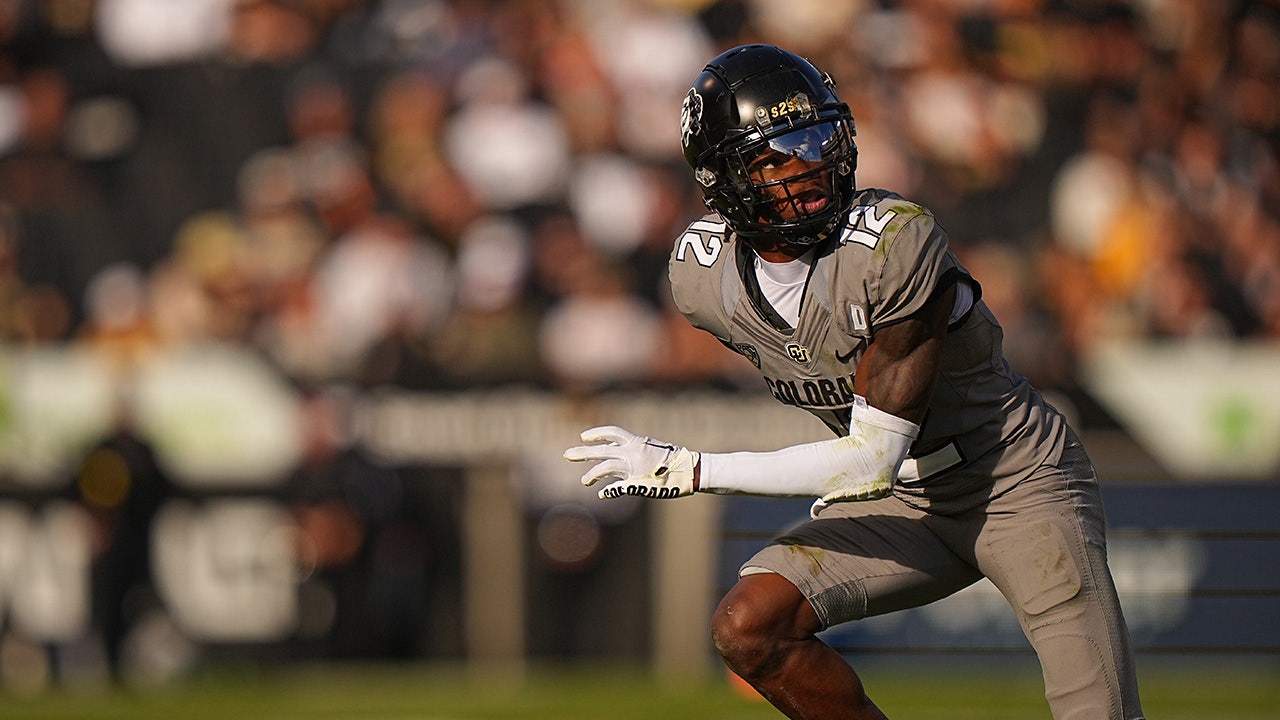
Lots of eyeballs will be focused on Boulder, Colorado, Thursday night, and that’s exactly how Travis Hunter wants it.
After being the talk of the offseason last year, Deion Sanders led his Colorado Buffaloes to a wild 3-0 start before a disappointing ending. They lost eight of their final nine games.
But Coach Prime is still on the sidelines. His son, a likely early selection in the NFL Draft, is the quarterback, and Hunter is a two-way superstar.
Colorado’s Travis Hunter plays pass coverage against Arizona at Folsom Field in Boulder, Colo. (Erick W. Rasco/Sports Illustrated via Getty Images)
Sanders should be commended for taking a 1-11 team in 2022 and winning three more games last year. And he deserves praise for putting the Buffaloes back on the college football map. But, for Hunter, it’s not about “hype” anymore.
“It’s not hype no more, just expectations. We know we gotta go out there and win,” Hunter told Fox News Digital in a recent interview. “We know we gotta put in the work. This offseason, that’s all we’ve been focused on — putting in the work, getting stronger, gaining weight, getting better lines, getting better guys so we know we can go out there and be comfortable going out there going to war.”
College football fans will be getting a look at all the offseason work the Buffaloes put in Thursday when they host North Dakota State. And, just like last year, Colorado’s games will be watched all over.
Is that added pressure? Sure. But Hunter doesn’t mind it.
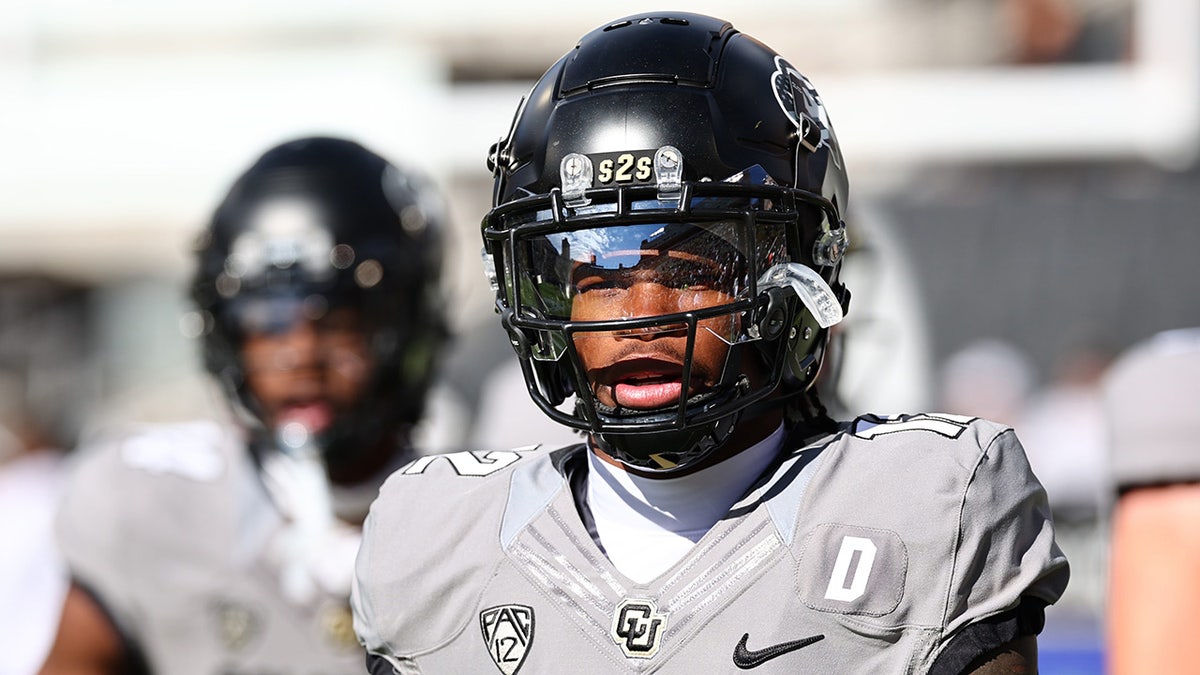
Colorado’s Travis Hunter against Arizona at Folsom Field in Boulder, Colo. (Jamie Schwaberow/Sports Illustrated via Getty Images)
TRAVIS HUNTER EXPLAINS WHY PLAYERS ‘CAN’T TAKE’ PLAYING FOR DEION SANDERS, COLORADO
“We know it’s a lot of eyes on us. But we just go out there and work. We know we’re gonna be seen, so we just go out there and work and try to be the best for each other,” Hunter said.
“I shine brighter when the lights are on. There’s never nothing wrong with people watching me. I just go out there and work.”
The Buffaloes entered their first game last season as 22.5-point underdogs to TCU, who had been fresh off a national championship appearance. Colorado won the game and rose as high as No. 18 in the country.

Colorado’s Travis Hunter on the field against Arizona at Folsom Field in Boulder, Colo., Nov. 11, 2023. (Erick W. Rasco/Sports Illustrated via Getty Images)
But the ending left a bad taste, and Hunter knows how they can improve.
“We gotta win more. We gotta win the clutch games where we lost by seven or less,” he said. “We’re right there. We just gotta finish those games right there. Our record easily could’ve been switched.”
Kickoff is at 8 p.m. ET Thursday.
Follow Fox News Digital’s sports coverage on X, and subscribe to the Fox News Sports Huddle newsletter.
Sports
Why USMNT coaching target Mauricio Pochettino could turn to lemons in quest for World Cup glory

If and when Mauricio Pochettino moves to the United States and becomes U.S. men’s national team head coach, he’ll be in for an adjustment.
Atlanta, Georgia — the future site of U.S. Soccer’s headquarters and training center — is a far cry from Barcelona, Paris or London. Atlanta is, by most accounts, cosmopolitan, but it’s likely missing a bit of the Old World charm possessed by some of Pochettino’s previous stations in life.
Maybe he’ll work to decorate his office to give it a touch of those places. A photo of his former roommate and teammate at Newell’s Old Boys, Diego Maradona, might get thrown up on one wall. Maybe a jersey from his time at Paris Saint-Germain, or La Liga side Espanyol, the club that formed him more than any other.
And, of course, there will be lemons.
You see, in at least one sense, Pochettino is already uniquely equipped for life in America.
The 52-year-old Argentine has a bit of an obsession with the types of motivational techniques and borderline supernatural beliefs that many Americans are obsessed with.
GO DEEPER
Is becoming USMNT head coach the right move for Mauricio Pochettino?
If you’re an insomniac, you’ve probably seen the late-night infomercials. Pochettino will speak of auras, of self-determination, of bravery. He’ll walk you over hot coals, or walk you into a wall with an arrow pressed to your throat. Spend enough time around the guy and you might end up in a trust fall.
And then there are the lemons. Walk into Pochettino’s office in Atlanta once he gets settled and you’ll surely see the lemons.
“An Argentinian friend told me that lemons absorb negative energy and cleanse the air,” Pochettino writes in Brave New World, a book which documents his five years as head coach of London-based Premier League club Tottenham Hotspur. “Which is why I have a tray of them in my office.
“We all have the potential to see the energy that surrounds objects and people, although not everyone has honed that sense. For whatever reason, I’ve been able to develop an ability which allows me to see others’ auras.”
Indeed, Brave New World, a breezy, 267-page read produced alongside Spanish author and journalist Guillem Balague, is full of motivational buzzwords. Search for the word “brave” and you’ll find some version of that word used on 18 different occasions. “Energy” is in there 40 times, “aura” a half-dozen. Lemons, well… they get just the one mention.

(Julian Finney/Getty Images)
Pochettino is famously thorough in how he prepares his teams for play, both from a tactical standpoint and from a fitness perspective. Equally as important, though, are his motivational beliefs and the faith he puts in his players. Those beliefs underpin everything Pochettino does as a manager. And in a way, many of those beliefs were formed with the help of Xesco Espar.
Espar first met Pochettino while the Argentine was finishing his playing career at Espanyol in the mid-2000s. A few years later, when Pochettino became that Barcelona club’s head coach during a fierce La Liga relegation battle, the two reconnected. Pochettino had read Espar’s book Jugar con el Corazon (Play from your Heart) — and felt it closely mirrored his own philosophies. Espar, a former handball player and coach who led FC Barcelona’s handball team to a European championship, was happy to help.

GO DEEPER
Who is Pochettino? Is this a coup for the USMNT? Will it help them at World Cup?
Years later, when Pochettino took over a promising Southampton side midway through the 2012-13 Premier League season, Espar remembers his friend feeling frustrated.
“The first time we talked (after he arrived) he said, ‘These players are much better than they think’,’” says Espar. “‘We have to do something to make them realize this’.”
Espar and Pochettino pulled their solution right out of an American corporate retreat.
In the following preseason, the squad went to Espar’s home base in Spain for a few days of seminars and motivational talks. And then they all filed outside, where they saw a bed of hot coals laid out in front of them. Pochettino went first, calmly and cooly traversing the briquettes without a hint of hesitation. Newcomer and current CF Montreal midfielder Victor Wanyama had a tougher time, as did 31-year-old striker Rickie Lambert, who approached with clear hesitation. In the end, they all passed over the coals, egged on by their teammates and by Pochettino himself.
“It was just a metaphor for breaking your own beliefs about yourself and what you can do,” says Espar. “And they had an amazing season. They were safe (from relegation) very quickly (and finished eighth in the 20-club English top flight, Southampton’s highest final placing for 11 years). He trusts the players. This is one of his main characteristics.”

Pochettino used motivational techniques on his Southampton players (AMA/Corbis via Getty Images)
Espar picked up the hot-coals trick from Tony Robbins, who is maybe the poster child of self-help and motivational techniques in the United States. Pochettino also had his players do something a little bit more terrifying — place the shaft of an arrow on the soft tissue around their throat and lean against a board until it snapped.
His motivational beliefs, though, extend well beyond the Robbins-inspired team-building exercises. There’s his belief in the power of a handshake — at Spurs, Pochettino required players to shake his hand every morning as they entered the team cafeteria, and do the same with each other as well.
“When you touch some people, you feel the energy,” Pochettino once said in a podcast appearance. “You feel if it’s good, if they need love, if they’re upset, if they sleep well. You can have a lot of information that is so important afterwards to manage — you are not managing a robot, you are managing a person that you’re going to ask for the best form. You are going to try to get the best to try to achieve all that you want.”
Instituting mandatory handshakes was likely just a bonding exercise at Spurs, but to Pochettino, he may have been after something more. While the Argentine relies on sports scientists and analysts for performance data, he relies on personal contact with players to gauge another metric: their aura.

GO DEEPER
Pochettino’s tactics: How he can energise the USMNT ahead of the 2026 World Cup
“I believe nothing happens by chance,” Pochettino writes in Brave New World. “There is a reason for everything.
“Since those early days, I’ve had the ability to notice something powerful that you can’t see, but that does exist. A vital force, an energy field that makes the world go round, an aura that accompanies people, which gives lots of information about them. It’s in my skin, I feel it. (Wife) Karina and I call it ‘universal energy’. My wife helped me get to grips with it and gain a more in-depth understanding. Others helped me explore those feelings further. It isn’t superstition or black magic. I believe there is science behind it.”
American soccer fans are not unfamiliar with team-building or motivational quackery.
Previous USMNT boss Jurgen Klinsmann is German but was as close to a native Californian as he could be by the time he took the head coaching job in 2011, having lived there for the preceding 13 years, and it often felt like a lot of his remarks about players and his coaching philosophy felt steeped in West Coast self-help jargon.
If Pochettino’s trip over the hot coals feels like a scene out of The Office, Klinsmann took things a step further by having his players watch a 55-year-old dude in a tracksuit tear up a few phonebooks and bend a frying pan in half.
USMNT legend Tim Howard spoke about Klinsmann’s approach recently. He did not hold back.
“I don’t remember a time when there was a bigger disconnect between the players and the manager than under Jurgen,” former goalkeeper Howard wrote in the UK’s Daily Mail newspaper. “He organized a lot of team excursions. He specialized in fluff and philosophical rhetoric. But there was zero soccer.”
Such is not the case with Pochettino, of course, who would bring an extensive coaching resume with him and a reputation not only for man-managing but also managing the game itself. “He uses very advanced analytical techniques as well,” adds Espar. “He is not just a ‘motivational guru’ or something like that. He has a strong playbook, a strong model and methodology of the game and training and physical conditioning. It’s not just motivational stuff.”
The Argentine is explicit with players about positioning, almost micromanaging that aspect of the game, and about building play from the back. He also puts an extreme emphasis on trust and relationship building. Pochettino, famously, does not fine players for minor infractions and he never enters the changing room at the training facility. In many ways, he delegates much of the responsibility for leadership to the players themselves.
“He balances leadership and management,” says Espar. “Management is talking to the player’s head, leadership is talking to the player’s heart. He is very good at balancing those things. He has a strong structure in training, with practices, assistants, all of that work. And then he also trusts the players more than most other coaches. He gives the power to the players. He gives recognition to players, but he also gives accountability to them.
“For both of us, the difference between a championship team and a team that wins multiple championships is who holds the accountability. In a championship team, the coach holds the accountability. But in a multi-championship team, it is the players who hold each other accountable. That is one of the main philosophies for Pochettino. He sees the players better than what they already are.”
But let’s not forget about the lemons.
Because after all of this work, after forming a deep well of knowledge and crafting his own unique vision for his team, Pochettino still relies on a citrus fruit — at least a little bit — to turn the ship around.
The USMNT is in a bit of a low moment right now after having crashed out of this summer’s Copa America on home soil and is seeking a turnaround ahead of the 2026 World Cup, which they’ll co-host with Canada and Mexico. If Pochettino has anything to say about it, the lemons will probably play a part in that.
“They started to work after two years at Tottenham,” he said during his tenure at Spurs’ London rivals Chelsea last season. “Give time to the lemons. It is a thing that we all believe… They need a long time, they are not magic, but more than ever, I still believe in them.”
(Top photo: Sebastian Frej/MB Media/Getty; additional photo credit to iStock; Design: Dan Goldfarb)
-

 Connecticut6 days ago
Connecticut6 days agoOxford church provides sanctuary during Sunday's damaging storm
-

 Technology1 week ago
Technology1 week agoBreakthrough robo-glove gives you superhuman grip
-
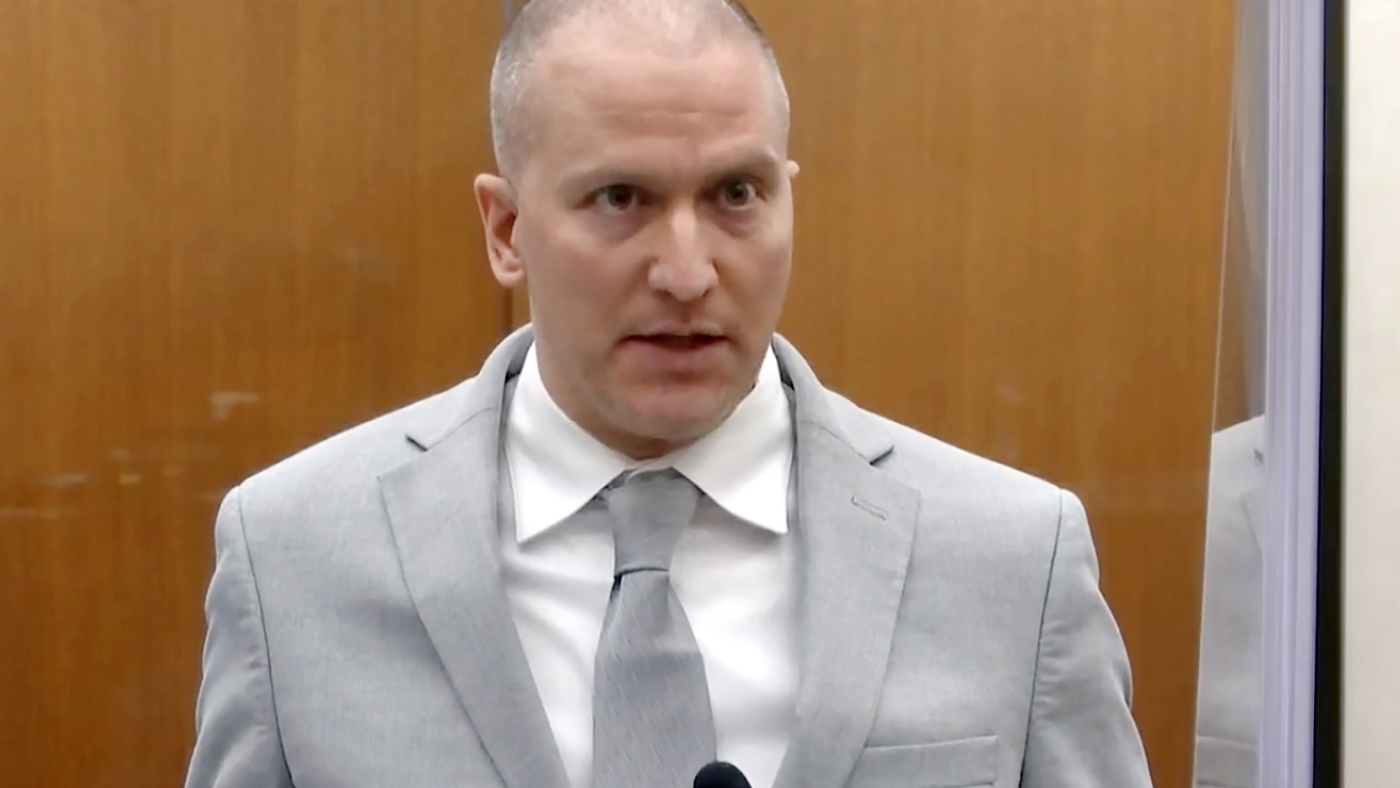
 News1 week ago
News1 week agoEx-officer convicted in George Floyd's killing is moved to new prison
-

 News1 week ago
News1 week agoVideo: Protesters Clash With Police Near the Democratic National Convention
-

 News1 week ago
News1 week agoVideo: Biden Delivers Keynote on First Night of D.N.C.
-

 News1 week ago
News1 week agoVideo: D.N.C. Holds Enthusiastic Roll Call to Nominate Harris
-
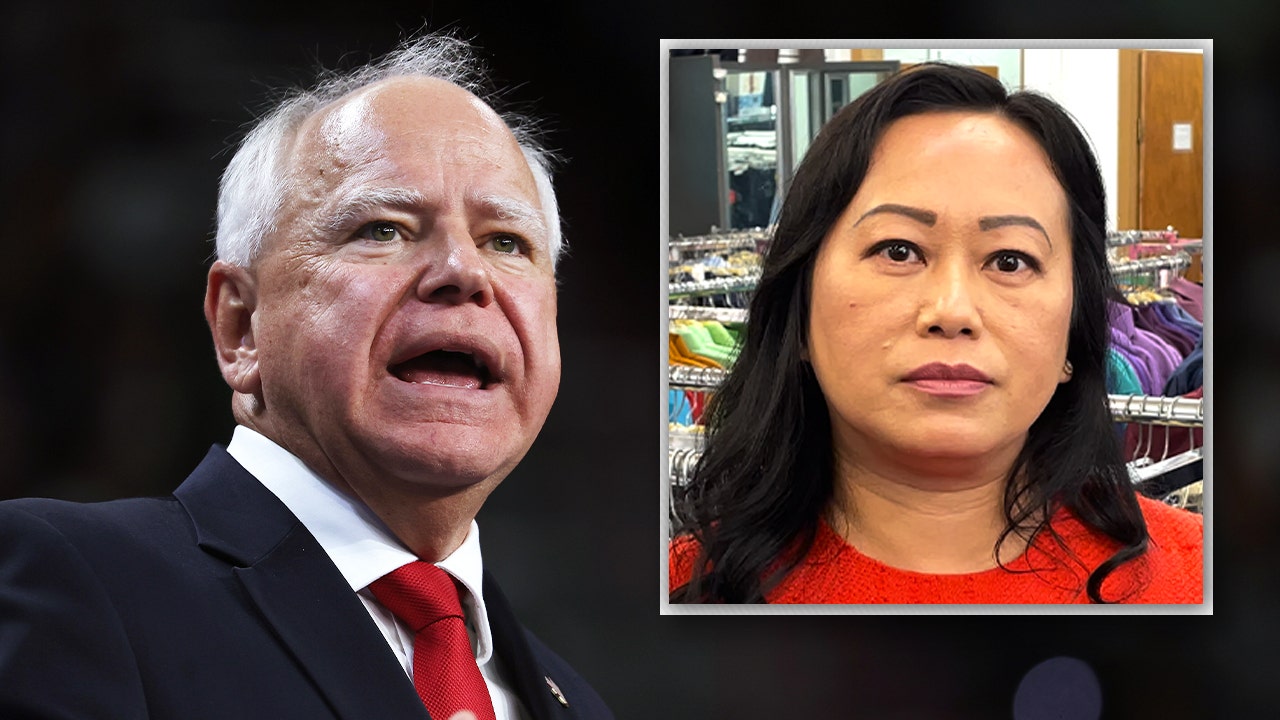
 Politics1 week ago
Politics1 week agoFormer teacher reveals which students suffered 'the most' under Walz's pandemic-era guidelines
-

 World1 week ago
World1 week agoPanama deports 29 Colombian migrants from Darien Gap under US deal










